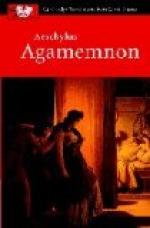The ancient blinded vengeance and the wrong that amendeth wrong.
Every wrong is justly punished; yet, as the world goes, every punishment becomes a new wrong, calling for fresh vengeance. And more; every wrong turns out to be itself rooted in some wrong of old. It is never gratuitous, never untempted by the working of Peitho (Persuasion), never merely wicked. The Oresteia first shows the cycle of crime punished by crime which must be repunished, and then seeks for some gleam of escape, some breaking of the endless chain of “evil duty.” In the old order of earth and heaven there was no such escape. Each blow called for the return blow and must do so ad infinitum. But, according to Aeschylus, there is a new Ruler now in heaven, one who has both sinned and suffered and thereby grown wise. He is Zeus the Third Power, Zeus the Saviour, and his gift to mankind is the ability through suffering to Learn (pp. 7 f.)
At the opening of the Agamemnon we find Clytemnestra alienated from her husband and secretly befriended with his ancestral enemy, Aigisthos. The air is heavy and throbbing with hate; hate which is evil but has its due cause. Agamemnon, obeying the prophet Calchas, when the fleet lay storm-bound at Aulis, had given his own daughter, Iphigenia, as a human sacrifice. And if we ask how a sane man had consented to such an act, we are told of his gradual temptation; the deadly excuse offered by ancient superstition; and above all, the fact that he had already inwardly accepted the great whole of which this horror was a part. At the first outset of his expedition against Troy there had appeared an omen, the bloody sign of two eagles devouring a mother-hare with her unborn young.... The question was thus put to the Kings and their prophet: Did they or did they not accept the sign, and wish to be those Eagles? And they had answered Yes. They would have their vengeance, their full and extreme victory, and were ready to pay the price. The sign once accepted, the prophet recoils from the consequences which, in prophetic vision, he sees following therefrom: but the decision has been taken, and the long tale of cruelty rolls on, culminating in the triumphant sack of Troy, which itself becomes not an assertion of Justice but a whirlwind of godless destruction. And through all these doings of fierce beasts and angry men the unseen Pity has been alive and watching, the Artemis who “abhors the Eagles’ feast,” the “Apollo or Pan or Zeus” who hears the crying of the robbed vulture; nay, if even the Gods were deaf, the mere “wrong of the dead” at Troy might waken, groping for some retribution upon the “Slayer of Many Men” (pp. 15, 20).




